The coronavirus that causes COVID-19 may survive for several days on some surfaces. Estimates of its exact lifespan vary, but the virus can clearly hang around long enough to make disinfecting frequently touched surfaces a priority. This is one of the CDC’s guidelines for protecting yourself and limiting the virus’s spread, and the Environmental Protection Agency (EPA) put together an exhaustive list of products that can do the job.
Normally, the home versions of these products are commonly available, but they’ve been widely out of stock as the outbreak has spread across the United States. As an alternative until inventory returns, you can make an effective homemade disinfectant from a mixture of water and bleach, which you may already have on hand. Whatever you use, it’s equally important to know how to use a disinfectant properly—that means allowing enough time for a disinfectant to do its job, which can be as long as 10 minutes.
Our pick
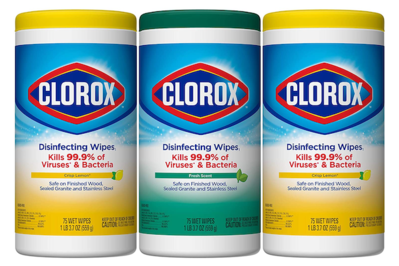
Clorox Disinfecting Wipes
Kill it with wipes
Effective, EPA-approved, and (usually) easy to find, these presoaked wipes need only four minutes of contact time to neutralize the coronavirus.Buy from Amazon
May be out of stock
*At the time of publishing, the price was $5.
Clorox Disinfecting Wipes, like the other picks in this guide, are not necessarily better than the other options; our advice is to get any of our picks that you can find, first of all. In non-pandemic times, Clorox’s bleach-free wipes are usually sold in single canisters or in four-packs at a range of retailers. These wipes can eliminate the coronavirus on hard surfaces in your home—countertops, bathroom fixtures, doorknobs, light switches, and tile and some wood floors—but not on fabric and other soft materials.
Our pick

Lysol Disinfecting Wipes
A killer, but slower
Another widely sold wipe, these are EPA-approved too, but they take 10 minutes to disinfect.Buy from Amazon
*At the time of publishing, the price was $10.
Lysol Disinfecting Wipes are also EPA-approved to disinfect hard surfaces, and are also (usually) widely available, either in a single canister or a six-pack. They employ the same non-bleach disinfectant as the Clorox wipes but take longer to work: 10 minutes versus four. Don’t let that be a concern—if you find them, get them.
Our pick
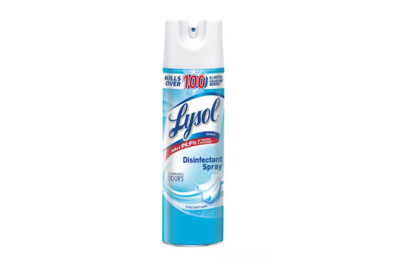
Lysol Disinfectant Spray
A smothering aerosol
This non-bleach aerosol spray works in 10 minutes. It’s fabric-safe but guaranteed to eliminate the virus only on hard surfaces.$6 from Target
Lysol Disinfectant Spray uses quaternary ammonium (quats) instead of bleach. It’s safe on hard surfaces and most fabrics, and it’s gentler on skin than bleach and produces fewer harsh fumes. It eliminates the coronavirus in 10 minutes on hard surfaces but only sanitizes (kills most but not all pathogens) on soft surfaces. Look for it also sold as a two-pack or three-pack.
Our pick
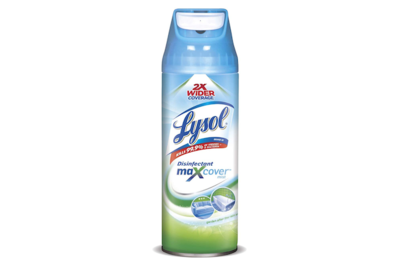
Lysol Disinfectant Max Cover Mist
Another non-bleach aerosol
This aerosol also works in 10 minutes and is fabric-safe, but again, it’s guaranteed to eliminate the virus only on hard surfaces.Buy from Target
May be out of stockBuy from Amazon
*At the time of publishing, the price was $6.
Like the similar Lysol Disinfecting Spray, Lysol Max Cover Mist is quats based and safe on both hard surfaces and fabrics but is guaranteed to eliminate the coronavirus only on hard surfaces, taking 10 minutes to do the job. It sanitizes but does not fully disinfect fabrics.
Our pick
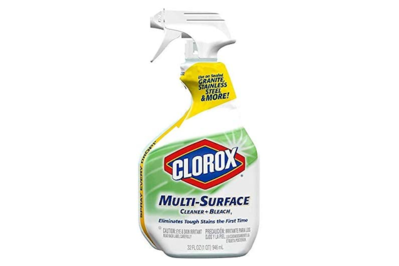
Clorox Multi-Surface Cleaner + Bleach
Spray it to death
This bleach-based cleaner works in one minute but will damage fabrics, and the fumes are harsh.$4 from TargetBuy from Amazon
Clorox Multi-Surface Cleaner + Bleach eliminates the coronavirus in one minute on hard surfaces, such as you find in kitchens and bathrooms—sinks, faucets, toilets, tile, and synthetic countertops. Any bleach-based spray like this is for use only on hard surfaces. It will damage fabrics, feel harsh on skin, and produce fumes that can irritate mucous membranes. Take basic precautions such as ventilating the room and wearing gloves.
Our pick

Clorox Clean-Up Cleaner + Bleach
Death spray version 2
Another bleach-based cleaner from Clorox, this one works in five minutes, and its fumes are also strong.Buy from Target
May be out of stockBuy from Amazon
*At the time of publishing, the price was $3.
This bleach-based spray eliminates the coronavirus in five minutes on hard surfaces and is for use on bathroom and kitchen surfaces. No fabrics. Wear gloves. Ventilate the room.
Our pick
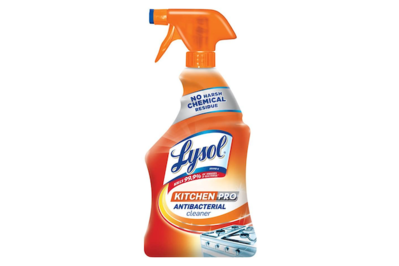
Lysol Kitchen Pro Antibacterial Cleaner
A non-bleach spray
This spray is based on a non-bleach disinfectant, so it’s safe on fabrics but guaranteed to eliminate the coronavirus only on hard surfaces.Buy from Target
May be out of stockBuy from Amazon
*At the time of publishing, the price was $3.
Unlike the other spray-bottle options on our list, this one is fabric-safe because it uses quaternary ammonium (“quats”) instead of bleach. It eliminates the coronavirus in two minutes on hard surfaces, whereas on soft materials it may sanitize—that is, kill most viruses and other pathogens present—but is not guaranteed to fully disinfect. It’s less harsh on the skin and produces less-noxious fumes than bleach-based products.
Our pick
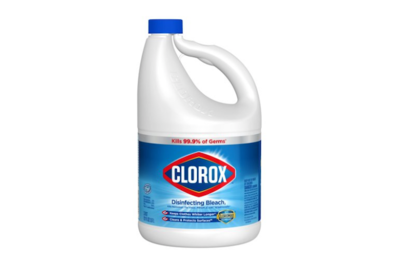
Clorox Bleach (121 ounces)
Good ol’ DIY bleach solution
Diluted in water, bleach is the key ingredient to a homemade disinfectant that’s as effective as it is noxious. Research how to safely handle and work with bleach if you’re new to this.Buy from Target
May be out of stock
*At the time of publishing, the price was $4.
Like you, we couldn’t find many of the above ready-to-use items for sale online in March 2020. But one thing has been consistently available: bleach. Clorox recommends a half cup of bleach per gallon of water to make a disinfectant solution; we’ve found the CDC recommending a more diluted version, and other experts suggest a more concentrated mix. Before you concoct any bleach-based disinfectants, be sure to learn how to use bleach safely and effectively. Start with our section on how to make a homemade disinfectant for the coronavirus.
How to use disinfectant sprays and wipes
To disinfect a surface, by far the most important consideration is what’s known as dwell time: the amount of time the disinfectant needs to remain on a surface to kill pathogens in general and specifically the coronavirus that causes COVID-19. No disinfectant works instantly; most of those sold to the public take several minutes. “I can tell you this, and you can print this,” Warner said, “that the EPA, when they’re dealing with an unknown pathogen—an unknown bacteria or virus—the protocol is 10 minutes across the board, in health care and anywhere.” That said, he added, “If they get EPA registration [on List N, for the coronavirus]for a dwell time of two minutes, one minute, that’s valid. It’s been tested.”
Different dwell times don’t indicate that one disinfectant is more or less effective than another. They’re just how long a given product takes to completely eliminate the coronavirus. “The EPA frowns on the use of dwell-time claims being used as an indication that one is better than the other,” Warner wrote in a follow-up email. “EPA List N registration supersedes all other claims, and documents each disinfectant as effective or not (equally).”
But dwell time is not the only thing you need to pay attention to.
Complete disinfecting protocol includes, officially, four steps: pre-cleaning, disinfecting, wiping clean, and rinsing with water. “But we’re lucky if we get two,” Warner said, meaning dwell time and wipe-up. Cleaning is most important on heavily soiled surfaces, because dirt can shield pathogens underneath; soap and water or a household cleaner is fine for this step. Disinfecting for the proper dwell time, of course, is nonnegotiable. Wiping clean afterward is important because disinfectants can leave a sticky residue where pathogens can quickly resettle. Rinsing “you mostly see in the pharmaceutical industry,” Warner said, and can probably be skipped.
Lastly, as Warner wrote in a follow-up, it’s best to dispose of prepackaged wipes or paper towels that you’ve used to disinfect surfaces. Reusable cloths and mops “should be exchanged for a new one often during a cleaning process, then laundered.” In medical facilities, he said, they are used for a maximum of three rooms before being washed. With a paper towel shortage, reusable cloths might be the way to go at home, too—let’s just hope you can still find some laundry detergent.
Can rubbing alcohol, hydrogen peroxide, or other household disinfectants kill coronavirus?
You may already have rubbing alcohol (a.k.a. isopropyl alcohol or isopropanol) or peroxide on hand.
The CDC specifically recommends the use of “at least 70% alcohol” as a method of disinfection for the COVID-19 virus; that is the strength of most rubbing alcohol sold in drugstores, both in liquid form and on pre-moistened wipes. In a guide to disinfecting medical equipment, the CDC notes that alcohol is effective on coronaviruses in one minute.
Hydrogen peroxide is not specifically recommended by the CDC for eliminating the COVID-19 virus on surfaces, but it is considered a nearly universal disinfectant, and a recent study finds that the coronavirus “can be efficiently inactivated by surface disinfection treatment” in one minute by 0.5 percent hydrogen peroxide. (Most store-bought hydrogen peroxide is stronger: 3 percent.) Also of note, from a different CDC guide to chemical disinfection of medical equipment: “Hydrogen peroxide is extremely stable when properly stored (e.g., in dark containers). The decomposition or loss of potency in small containers is less than 2% per year at ambient temperatures.” So a recently expired bottle you have on hand may still be effective.
Both rubbing alcohol and hydrogen peroxide are safe on almost all hard surfaces and on most fabrics, though it’s worth testing them in a hidden part of any clothing or upholstery that you want to treat, to make sure they don’t damage the dye. Hydrogen peroxide decomposes into water and oxygen gas, and rubbing alcohol evaporates, so neither leaves a film or residue behind.
Finally, a note on the use of vodka, which has been rumored to be a disinfectant. In the health care community, “alcohol” refers to both rubbing alcohol and to ethanol—the latter being the kind some people drink. However, the CDC considers ethanol effective only at concentrations of 70 percent or more. Other studies say 60 percent is sufficient. Either way, vodka is not a disinfectant: it is just 40 percent ethanol (80 proof). In theory, highly overproof liquor can be used. Everclear 151 (75.5 percent ethanol/151 proof), Everclear Grain Alcohol (95 percent ethanol/190 proof) and Spiritus Rektyfikowany (96 percent ethanol/192 proof; just ask for “Spiritus”) may be available at your local liquor store. They are highly flammable, so use caution, especially around the stove.
The competition
Below are the all-purpose cleaners we tested in an earlier version of this guide. None are considered disinfectants, so while the pandemic is ongoing, we are not recommending them as a first choice. That said, all of them contain surfactants, a class of compounds that break up fats and make them soluble in water. That’s the same chemical process that makes ordinary soap and dish detergent effective against the virus when hand-washing.
Puracy Natural Multi-Surface Cleaner, our former top pick, did best overall while not damaging any surfaces. Our tests encompassed all-purpose cleaners’ ability to remove multiple stains and soils on hard surfaces and pans, including cooking oil, wine, baked-on tomato sauce, soap scum, and crayon on walls (which none was effective at removing).
Method All-Purpose Cleaner, our former runner-up, performed nearly as well as Puracy and is usually more widely available.
Clorox Green Works Multi-Surface Cleaner was a middle-of-the-pack performer in our tests, as was Mrs. Meyer’s Clean Day Multi-Surface Cleaner.
Up & Up All-Purpose Cleaner with Bleach (a Target-exclusive brand), Method Antibac All-Purpose Cleaner, and Formula 409 All-Purpose Cleaner gave some of the worst performances in our tests. The Formula 409 does contain quaternary ammonium, or “quats,” a widely-used disinfectant that’s employed in several of our picks above. But it is not on the EPA’s List N for approved coronavirus disinfectants.



